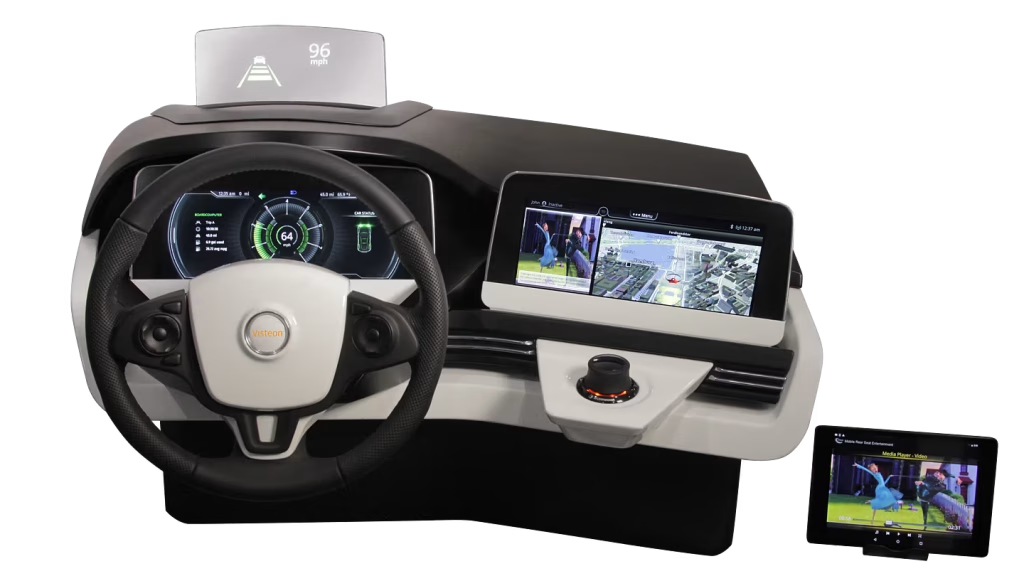Since its mechanical beginnings, the contemporary vehicle has developed into a highly advanced technical platform with harmoniously functioning digital and physical systems. The intelligent digital cockpit, a ground-breaking interface that radically alters how drivers interact with their cars, is at the heart of this revolution. At the forefront of this development is RUTOMATRIX, which combines several data streams, sophisticated computing power, and user-friendly interfaces to produce driving experiences that are more connected, safer, and customized than in the past. This essay examines eight significant facets of how this cutting-edge embedded system design is changing how we interact with cars.
1.Unified Data Architecture Transforming Vehicle Interfaces
RUTOMATRIX’s core innovation is its unified data architecture, which combines data from many car systems to provide a seamless experience. This method produces a comprehensive system where navigation, entertainment, car diagnostics, and driver assistance features continually exchange data, in contrast to old automotive interfaces that functioned as separate modules. The fragmentation that previously defined car interfaces—where drivers had to alternate between many systems with disparate advanced design solutions—is eliminated by this unification. Contextual awareness that anticipates driver demands based on thorough system understanding is made possible by the architecture, which creates a digital basis where every vehicle function becomes a part of a linked ecosystem rather than a stand-alone feature.
2.Adaptive Interfaces Responding to Individual Driving Patterns
RUTOMATRIX sets itself apart with interfaces that change according to user preferences and driving habits. The interface is gently improved based on the system’s ongoing analysis of interaction patterns, including which functions are most commonly utilized, what information is prioritized, and how various drivers within the same family use the car. Less-used options are still available without taking up too much space on the screen, while frequently used ones are given more prominence. This customization goes beyond basic layout choices to incorporate timing modifications, acknowledging that the information requirements for highway cruising and low-speed urban driving are different. As a result, the interface seems to anticipate demands rather than only reacting to explicit commands, becoming more natural with continuous usage.
3.Contextual Awareness Through Environmental Integration
The intelligent cockpit integrates a great deal of environmental knowledge into its functioning to achieve exceptional responsiveness. In order to modify the way and timing of information presentation, a number of sensor systems continually collect data about the surrounding traffic circumstances, weather patterns, road quality, and visibility variables. Unnecessary messages are automatically turned off when traversing complicated junctions to avoid distraction, and inclement weather causes safety-critical information to be shown more prominently. With automated brightness adjustments that react to ambient light levels and simplified interfaces for nighttime driving, contextual intelligence also extends to time-based aspects. The vast amount of information that is accessible is efficiently filtered by the system according to its relevance to the driving circumstances at the moment.
4.Multimodal Interaction Enhancing Safety and Convenience
Through advanced multimodal input detection, RUTOMATRIX dramatically improves vehicle engagement by enabling drivers to manage systems in the way that is most suitable for any given circumstance. Voice commands, touch interfaces, physical buttons, and gesture detection are all seamlessly integrated into the system, giving drivers the freedom to select the engagement style that minimizes distraction and optimizes convenience. While physical controls offer tactile feedback for essential activities that rely on muscle memory, voice recognition manages complicated demands during highway driving when hands should stay on the wheel. Compared to systems that require adaptation to a single control paradigm regardless of the driving scenario, this flexibility significantly reduces the cognitive strain by acknowledging that diverse situations demand for different interaction techniques.
5.Predictive Intelligence Anticipating Driver Needs
The capacity of RUTOMATRIX to forecast driver demands using advanced predictive algorithms that examine patterns over time is arguably its most revolutionary feature. Without specific requests, the system proactively provides pertinent information based on common travels, such as weekend destinations, school drop-offs, and commute routes. Favorite entertainment alternatives become easily available on known leisure trips, while traffic conditions for the usual route emerge automatically prior to the morning commute. Predictive capabilities also include environmental controls, driver alertness monitoring, and maintenance scheduling. Through careful preparation, this forward-thinking intelligence turns the car from a passive instrument into an active companion that lessens the mental strain involved in driving.
6.Seamless Digital Integration Beyond the Vehicle
Through careful interaction with the larger digital environment that influences modern life, RUTOMATRIX expands its intelligence beyond the actual vehicle. Journeys scheduled on other devices may be immediately transferred to the car navigation system thanks to the system’s ability to provide continuity between the home, mobile, and vehicle settings. Routing recommendations are influenced by calendar appointments, while home automation systems use arrival time signals to modify ambient settings. Media experiences seamlessly switch across devices, with music or podcasts picking up just where users left off when they got into the car. By recognizing that cars are only one part of our interconnected lives rather than discrete settings, this ecosystem approach brings consistency to digital touchpoints that were previously distinct realms.
7.Advanced Safety Through Driver Monitoring Systems
By using advanced driver monitoring features that adjust vehicle behavior to human situations, the intelligent cockpit greatly improves safety. To develop a thorough picture of driver state, many sensor systems monitor tiny markers of attention, weariness, and cognitive load, such as eye movement patterns, microexpressions, posture changes, and interaction timing. The system may change climate controls, highlight alerts more prominently, or recommend breaks when tiredness symptoms start to show. When patterns of distraction appear, non-essential messages are momentarily blocked and safety-critical information is given visual prominence. By developing an active system that understands that driving performance is closely correlated with human cognitive and physical conditions, our human-centric safety approach goes beyond conventional passive protection.
8.Continuous Evolution Through Over-the-Air Refinement
Through an architecture created especially for ongoing evolution through over-the-air upgrades, RUTOMATRIX remains relevant throughout the vehicle’s lifecycle. This method allows for frequent improvements based on new technology, shifting usage patterns, and enhanced algorithms, in contrast to previous automobile systems that stayed mainly unchanged after purchase. Voice recognition systems may accommodate increased language capabilities, interface layouts can be adjusted based on aggregate user interaction data, and new features can be easily integrated without needing hardware adjustments. The interaction between drivers and cars is changed by this evolutionary capability, which produces technology that becomes more advanced over time rather than becoming less relevant in comparison to newer models.
Conclusion
From discrete mechanical controls to interconnected, intelligent systems that are always learning and adapting, RUTOMATRIX pcb design in usa signifies a major change in vehicle interface design. This technology turns automobiles from passive tools into responsive companions by integrating data sources, customizing interactions, and anticipating demands. These technologies promise more individualized, safe, and smart driving experiences as they develop further, blending in perfectly with our linked lives.







